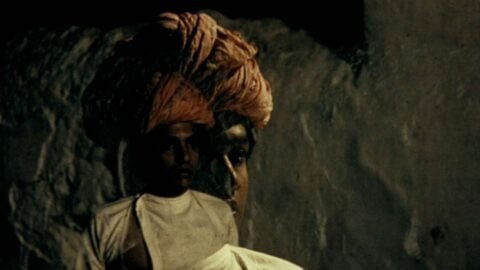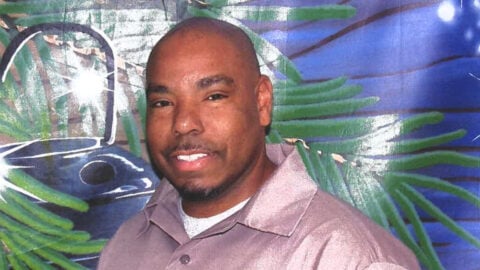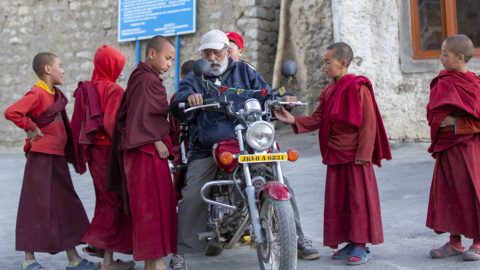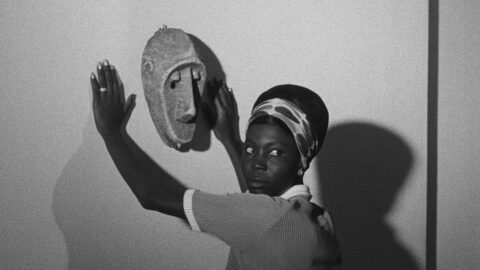Interview: Eugène Green
Perhaps as a side effect of being forced to watch Battleship Potemkin multiple times in film school, many contemporary critics use “formalist” as a pejorative. However, the films of Eugène Green adhere to the rigorous conventions of the Baroque theater and succeed in parsing philosophical issues with a winning wry sense of humor. His latest, La Sapienza, is a rich work that approaches the experience of aging through two sets of couples: French middle-aged married professionals who have lost their passion for work and each other in the face of the modern world; and an adolescent Italian-Swiss brother and sister. Meeting by chance in a park in Switzerland, the couples pair off by gender. Alexandre (Fabrizio Rongione) reluctantly takes his younger counterpart Goffredo (Ludovico Succio) under his wing, repeating a tour of Italian architecture he undertook as a student, and their relationship slowly comes to mirror that of Baroque architect Francesco Borromini and his younger assistants. At the same time Alexandre’s wife, Aliénor (Christelle Prot), and Goffredo’s sister, Lavinia (Arianna Nastro), establish a thoroughly nurturing and warm rapport.
FILM COMMENT digital editor Violet Lucca spoke to Green after La Sapienza’s premiere at the Locarno Film Festival.

How do you go about composing a frame? Do you begin with an image or do you begin with an idea?
Actually, all of my frames are composed, at least basically, when I write the script. If there’s a dialogue, it’s more that I have my own convention for making something strong come out of the actor when he’s speaking. At the beginning, since it’s less intense, I film in a more or less normal way: that is, the camera is behind one of the speakers so that you see his shoulder or part of his head, what in French is called en amorce, and then you see the other character looking at the person he’s talking to. But when it becomes more intense, I start putting the camera between the two characters, so that the spectator receives fully what someone [in the conversation] would receive. I think about the progression so that usually the intensity increases, the frame becomes more and more close-up. The waist, then chest, then bust [i.e., head and shoulders], and then just part of the face. And then if it’s a very long conversation, as in The Portuguese Nun [09], where there’s a 20-minute conversation, I go farther away and then closer again. So these are very simple things, but that’s what I like. Simple things are, for me, strongest.
I also like to try and capture the energy that comes from absence, or from absence after presence. So, for example if a character is going to enter the frame, I usually start with an empty frame and, for example a foot shot, a foot frame—I do a lot of foot frames. I often start on the ground and then the feet enter, so the spectator feels the distinction between the empty space where there’s no presence and the physical presence. And then sometimes if a character goes out of the frame, I still keep the camera there because I want the spectator to feel the transformation of the inert matter, where there is still the personal energy of who was there, who is no longer visible but who remains present by his energy, and by his absence.
Why did you choose this particular Baroque rivalry and pair it with this contemporary story of these older people being revitalized and finding meaning through mentorship?
Because Borromini for me represents the true artist—that is, an artist who believes in his art and whose first concern is not to succeed socially but to go through what he thinks is the necessary path towards his art. When people think about the history of architecture and Romans in the 17th century, it’s always the rivalry between Borromini and Bernini. And for me it represents two points of view in relationship to art. It’s something very vital and with a great deal of meaning today, because a great deal of what is produced today as art is actually just a means of getting wealth and social position, but there’s no real artistic engagement. Often the most interesting artists are not the most visible in the social sphere.
There’s also a spiritual conflict. In France the conflict is very important in the 17th century, between the Jansenists and the Jesuits. And for me, the French have an ideology which came from the 18th and 19th century, and which is taught in school as distinct about France from all other countries—France being classical and not having gone through “Baroque is a sin.” They always oppose what they call French classicism—the word didn’t exist in the 17th century, and even less the concept—to Roman baroque. But actually, in the context of French culture—as in the way that I define Baroque culture—the culture around Port-Royal, the center of Jansenism, was actually the most Baroque culture in France. I make a parallel between that opposition and the opposition between Borromini and Bernini.
Bernini worked mainly for the Jesuits and his spiritual director was Gian Paolo Oliva, who was the Supreme General of the Jesuits. Borromini was very pious but it was a private sort of piety. In the Roman context, his work resembles what the Jansenists value in French [architecture] because it’s very pure, it’s all just white. For example, in the Sant’Ivo alla Sapienza [a church Borromini designed], it’s just white forms, but the energy comes from the conflict between the forms and not from just superficial decoration, which is mainly what Bernini [used], at least in his decorative style. Sant’Andrea al Quirinale is also purified but it’s very academic actually, it follows rules, and…voila. Have I answered your question? [Laughs]

And why did you pair this story with the story of the architect and his wife?
Because what he goes towards is la sapienza—sapience in French—that is, knowledge which leads to wisdom, which is not the same thing [as knowledge]. In all pedagogical relationships an older person can always give information and know-how to the younger person, but a younger person can also bring a spiritual opening to it. I have to get along very well with younger people and now, even though I am not very well known, a certain number of young artists contact me and I’m in contact with them because they want me to look at their work, and I do that very willingly. But at the same time it’s not completely altruistic, because I learn things also from them. It’s not egoistic either—
It’s an exchange.
It’s an exchange, it’s a human relation, and I think that happens with the two couples, the two men and the two women [in La Sapienza]. And also there’s the idea of sacrifice, which is at the heart of all religions, actually, and the subject is opened already when they go to visit the Holy Shroud, because Goffredo realizes that, if it really isn’t the shroud of Christ, then he says it’s the shroud of another Christ that has also been sacrificed. There’s the idea that an artist is not a martyr but someone who gives, who makes a sacrifice in his life. We know nothing about Borromini’s personal life—he had apparently no real personal life. He had some friends with whom he had some intellectual exchanges, but otherwise he was a completely solitary person. And so when, in the scene that [dramatizes] Borromini’s relationship with his young assistant, he says that “I did the sacrifice for you,” Alexandre realizes it’s also for him, and that in a certain way Borromini made a sacrifice for him through his art and also through his life. It’s a sort of Christ-like idea that the artist is a human reflection of the sacrifice and the spiritual sacrifice.
There’s a lot of doubling in the film: visually, such as when the older couple is eating at the dinner table in the restaurant, and in a broader sense, in the two deaths that shape their lives. How did you choose that motif? Is it referencing architecture or is it something in a different direction?
No, I always say that one of the reasons why I feel so strange about my work is that modern thought is always conceptual—it begins with concepts and evolves rationally. Whereas I naturally have—it’s not something I choose [laughs]—what I call a “mythical” way of thinking. In contemporary language, when someone says that something is “mythical,” that means it’s not true, but that’s the opposite of the word’s real meaning. The word “myth” comes from mutos in Greek, and in the archaic Greek and Homer, mutos means “truth-sayer,” and in the classical period it takes the meaning of a story, a narration. It always means a narration which by simple unfolding expresses a truth. And so I tend to think in mythical terms. I’m not very enthusiastic about psychoanalysis. I think I’m closer to Jungians than Freudians. So this idea of doubling as you say, it came naturally to me; it had to be part of the story, and afterward I realized what it meant, but at first it just came as if I was telling a story to children to bedtime and it came that way. And then I realized that I was right to do it because it had a lot of meaning.

How do you choose your actors? How much room do they have to experiment with a gesture or a vocal inflection?
I choose them mainly for what I feel that they have as a person. Also for their physical aspect, but for me the physical aspect always suggests something interior. Christelle Prot, I’ve worked with her in several films. I did my first film [Toutes les nuits, 01] with her, which I shot in 1999, so it’s been 15 years. And Fabrizio [Rongione], I’ve seen him in a lot of films—in all the Dardenne Brothers films and in certain Italian films. The Dardenne Brothers co-produced one of my films, and when we presented it in Brussels, I found him also interesting as a person, and in addition he’s bilingual. The two young actors, we had to do auditions to find them. There were auditions in Turin, and they sent me videos of the audition. I didn’t know Arianna had an important part in another film, but of all the girls I saw, she interested me the most. And Ludovico, I think for the [part of the] boy they did at least 30 or 35 videos, and the only one who interested me at all was Ludovico. He has a physical aspect which corresponds often to my young men characters, but there was something, his way of speaking, something interior which cannot be quantified. And when I met them both I was sure that they were the right choices.
As far as working with them, we just do usually one or two readings of the script before shooting, and I prevent them from making psychological intonations, because psychological intonations are always forced. They come from the psychological theater, and people have the habit now of accepting them as real or natural, but they’re not natural at all. For example, if you say a sentence, when there’s a punctuation you do a descending cadence and when there’s a full stop you do a big descending cadence. And in psychological acting, since the actor doesn’t want to recognize that he’s saying a text that has already been written, when there’s a punctuation he always goes up. So I just make them go down. Otherwise I just ask them to talk as if they were talking to themselves, because I don’t want them to think, I don’t want an intellectual interference with the flow of interior energy. When you speak to yourself, the words have a lot of importance, but you don’t try to convince yourself of something, so you’re not looking for rhetorical devices.
I voice a lot of affection for the actors that I film with Raphaël [O’Byrne, DP on all Green’s films]. Recently there was a screening in Paris of Toutes les nuits, my first film, which I hadn’t seen it in five years. And two of the main actors were there, and Raphael as well, and they were very moved. Someone came to see me and said that you can see how much compassion I have for the characters—and actually the actors because the actors are the characters. It’s a nice word: compassion not in a patronizing sense, but in the sense of a spiritual communion and understanding.
I have one more question. So the character you play—
The Chaldean.

You might see that as expressing some feelings you have about the U.S., or why you left the U.S.?
No, it’s related to the powerful connection between architecture and existence, for the group or for the individual, which the Chaldeans [evoke]. The Chaldeans are being chased out of Mesopotamia [editor’s note: an area that includes Iraq, Syria, Iran, and Turkey], which is where they have been living for 2000 years, probably even more than that. But no, as far as what I call “Barbaria” [the U.S.] in the film, I had the impression when I was very young, 5 years old, that everything that goes through me is language, and what was spoken around me, I didn’t feel it had that value. So I started on a quest to find the language. When I was an adolescent, I thought I was going to go to Great Britain or Ireland to make my life through English, but I realized that even English, real English, doesn’t correspond to my interior being, and it had to be another language. So it became French. [Laughs] I respect English, but…
What made you choose that particular culture, the Chaldeans, anyway?
I just shot a documentary on the Basques, but the Basques resist, whereas before the “Barbarians” made their war in Iraq, there were a million Chaldeans. It’s not only that they have a religion, but they have a language, which is the only vestige of what was the general language of all the Middle East. It was the language of Jesus, it was the language of the Jews at the time of Jesus, and this language is only living as the language with this population now. It will be like Yiddish or another language where the people are dispersed, the survivors. After one generation, the language will disappear.
The language of the Chaldeans is one of the bases of our European culture, because it was the language of Jesus and the apostles and probably the first Gospel, and St. Matthew was probably first written in Aramaic. So it’s related to the fact that all of our culture is disappearing. But besides its value as the disappearance of a language from a human group, it could have been a Caucasian language or a language from South America, of course.







